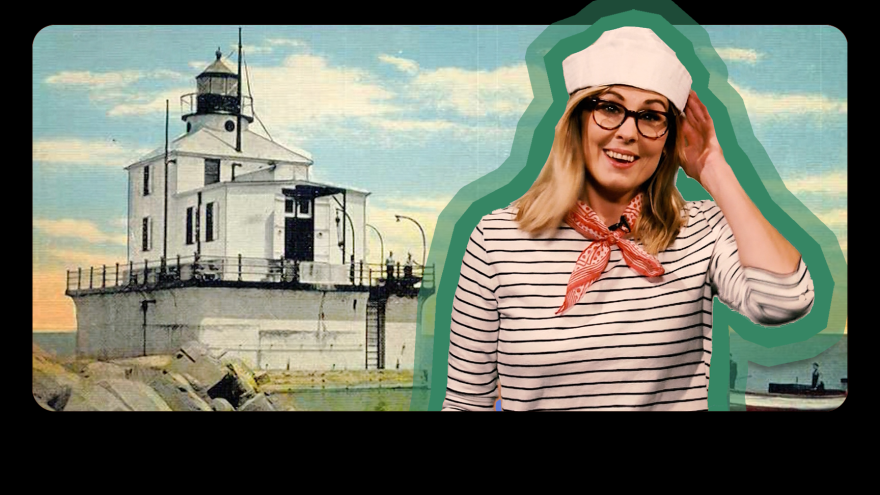Ohio's North shore is filled with ports important to trade in the state. Mary walks us through a few lighthouses that guided trade merchants to our state.
Class Discussion Questions:
1) Why are lighthouses important to Ohio?
2) Compare the Marblehead Lighthouse and the Toledo Harbor Lighthouse.
Read the Script:
Ahoy! Gotta get the position of my sailor hat just right here because today, we're gonna cruise along Ohio's beautiful north shore, which is a splashing good time for boaters and fisherman, but also a very important dock for trade.
For hundreds of years, large ships carried things like grain, lumber, coal, and iron ore in and out of the ports along Ohio's North Coast, and they continue to do so today. These ships are working at all hours of the day and night, so sometimes when they dock, Ohio's picturesque coast looks like this. Not exactly an image worthy of a postcard. Lake Erie can be a very dark place for boats. So, they need a guiding light to keep them safe and that's the important job of Ohio's lighthouses.
Perhaps the most well-known is the Marblehead Lighthouse. Nestled on the tip of a peninsula just north of Sandusky and Cedar Point, it's the oldest continually running lamp on the Great Lakes. In 1815, the government set aside $5,000 to build the lighthouse to guide boats safely into Sandusky Bay. The lighthouse was completed in 1821, but the source of the light wasn't a lightbulb. Those wouldn't be invented for another 50 years. Instead, the light at the top of the lighthouse consisted of seven oil lamps with reflectors. Each evening the lighthouse keeper, Benajah Wolcott, would climb to the top of the building and light the lamps. He also kept track of the ships that came and went and the weather conditions. When he passed away his wife Rachel took up the duties, making her the first female lighthouse keeper on the Great Lakes.
The Marblehead lighthouse has that traditional shape that you're probably familiar with, but the Toledo Harbor Lighthouse has a much different shape. It's less lighthouse, and more gingerbread house. Big freight ships headed to Toledo are guided by this unique lighthouse that was built in 1901. It's actually located in Lake Erie about five miles from the shore, so it's surrounded on all sides by water. So if you're the keeper of this lighthouse, chances are you're not a people person. The light in this lighthouse was called a fresnel lens, a special bullseye-shaped lens that bends light so it shoots out in a strong beam like a spotlight. Nowadays, the lighthouse is automated, so there's really no need for anyone to live out in the middle of Lake Erie, as much as some of us would like to.
Over on the other side of Ohio's coast, a lighthouse in Ashtabula is being kept alive by a group of concerned citizens. The original lighthouse was built at the mouth of the Ashtabula River in 1836. Over the years it has taken many shapes, and even been moved. First, the lighthouse was a hexagonal tower. Then, it was rebuilt as a square pyramidal tower. Finally, the latest version was a rectangular building. In the summer, a conservation group gives tours of the lighthouse. This was the last lighthouse of Lake Erie to be manned by a keeper until 1973. Although "lighthouse keeper" is no longer a job title for anyone in Ohio, lighthouses still provide an all-important guide for ships traveling in and out of the Buckeye State.
Instructional Links
Website: Lighthouses of the U. S, Ohio & Lake Erie Lighthouses https://www.unc.edu/~rowlett/lighthouse/oh.htm
Website: Lighthouse Friends, Ohio Lighthouses http://www.lighthousefriends.com/pull-state.asp?state=OH&Submit=Go




